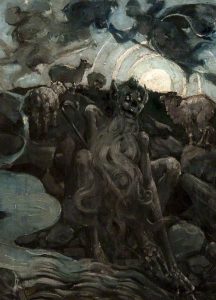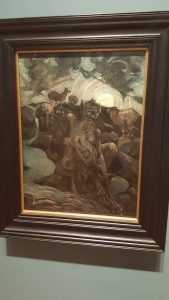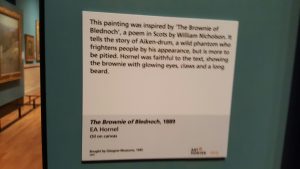The last time I was in Glasgow I came across this rather spooky painting of Aiken Drum or ‘the Brownie of Blednoch’ by E.A. Hornel (1889) in the Kelvin Grove Gallery and Museum

The image is inspired by a poem in Scottish dialect by William Nicholson (1782-1849). The intriguing folkloric ballad appears in the third edition of his posthumous Poetical Works in 1887. Aiken Drum is a devilish creature who inspires great fear in humans and animals:
The black dog growling cowered his tail,
The lassie swarfed, loot fa’ the pail;
Rob’s lingle brak as he men’t the flail,
At the sight o’ Aiken-drum.
In the painting he is a gloomy phantom or Brownie but the name also has historical links. There is a rhyme by James Hogg which appeared in Jacobite Reliques in 1820 which also mentions the character Aiken Drum. In fact it is a Jacobite song about the Battle of Sheriffmuir (1715) and not a story about a phantom at all:
Ken you how a Whig can fight,
Aikendrum, Aikendrum?
Ken you how a Whig can fight, Aikendrum?
He can fight the hero bright,
With swift heels and armour light,
And his wind of heav’nly might, Aikendrum, Aikendrum!
Is not Rowley in the right, Aikendrum?
Sir Walter Scott also refers to this mysterious figure in his novel The Antiquary (1816) in a story told by an old beggar. I think this may be a case of history becoming myth and myth becoming history. I have been pondering what links this historical person with the popular Scottish song ‘Aiken Drum’ and what links the song with the poem about the brownie and the painting? I find this very curious indeed. The song (which you will probably know) is quoted in full in Iona and Peter Opie’s Oxford Dictionary of Nursery Rhymes as follows:
There was a man lived in the moon, lived in the moon, lived in the moon,
There was a man lived in the moon,
And his name was Aiken Drum.
Chorus
And he played upon a ladle, a ladle, a ladle,
And he played upon a ladle,
and his name was Aiken Drum.
And his hat was made of good cream cheese, of good cream cheese, of good cream cheese,
And his hat was made of good cream cheese,
And his name was Aiken Drum.
And his coat was made of good roast beef, of good roast beef, of good roast beef,
And his coat was made of good roast beef,
And his name was Aiken Drum.
And his buttons made of penny loaves, of penny loaves, of penny loaves,
And his buttons made of penny loaves,
And his name was Aiken Drum.
And his waistcoat was made of crust pies, of crust pies, of crust pies,
And his waistcoat was made of crust pies,
And his name was Aiken Drum.
And his breeches made of haggis bags, of haggis bags, of haggis bags,
And his breeches made of haggis bags,
And his name was Aiken Drum.
In the nursery rhyme Aiken Drum wears entirely edible clothes and Brownies are usually associated with food. They often make themselves responsible for the farm or house in which they live by doing chores that have been left undone by servants or by herding sheep (see painting) or collecting eggs. A brownie will often become personally attached to a member of the household and in return he has a right to a bowl of cream or best milk or to an especially good cake or cheese! Brownie’s are often given clothing in exchange for their work but money or reward is thought to drive them away. William Henderson’s Folklore of the Northern Counties describes the little treats left for brownies as ‘knuckled cakes made of meal warm from the mill, toasted over the embers and spread with honey’ (cited in Katherine Briggs, A Dictionary of Fairies p. 45). This association with food and clothing does seem to link the Aiken Drum of the song with the Scottish Brownie and there are some descriptions in Briggs of the Brownie as looking monstrous, having no nose or an enormous mouth and webbed fingers or claws. It is this monstrous Brownie that is shown in the painting and described in the poem by Nicholson:
“Sauf us!” quoth Jock, “d’ye see sic een;”
Cries Kate, “there’s a hole where a nose should hae been;
And the mouth’s like a gash which a horn had ri’en;
Wow! keep’s frae Aiken-drum!”
For those who prefer the innocent sing-a-long version there is a rather fun contemporary rendition of ‘There was a man lived in the moon and his name was Aiken Drum’ on Youtube here
I’d love to hear any thoughts on this version….dino nuggets!?


